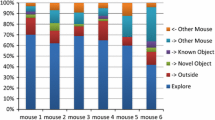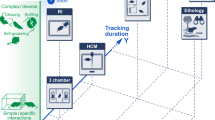Abstract
Although animal models cannot broadly represent uniquely human psychiatric or psychological syndromes such as anxiety, depression, or schizophrenia, behavioral testing in rodents can be extremely helpful to investigate specific disease aspects and symptoms. Animal behavioral test batteries allow researchers to reveal specific behavioral changes in genetically modified mice or following targeted treatments or in response to environmental interventions. Examples of types of behaviors that can be combined in a test battery include anxiety-like behavior, learning and memory, depression-relevant behavior, social interaction, and locomotor hyperactivity. Here, we describe several commonly used and relatively simple behavioral tests which can be combined in the same cohort of animals.
Access this chapter
Tax calculation will be finalised at checkout
Purchases are for personal use only
Similar content being viewed by others
References
Petković A, Chaudhury D (2022) Encore: Behavioural animal models of stress, depression and mood disorders. Front Behav Neurosci 16:931964
van den Buuse M, Garner B, Gogos A, Kusljic S (2005) Importance of animal models in schizophrenia research. Aust N Z J Psychiatry 39:550–557
Chadman KK, Yang M, Crawley JN (2009) Criteria for validating mouse models of psychiatric diseases. Am J Med Genet B Neuropsychiatr Genet 150b:1–11
van den Buuse M (2010) Modeling the positive symptoms of schizophrenia in genetically modified mice: pharmacology and methodology aspects. Schizophr Bull 36:246–270
Wall PM, Messier C (2001) Methodological and conceptual issues in the use of the elevated plus-maze as a psychological measurement instrument of animal anxiety-like behavior. Neurosci Biobehav Rev 25:275–286
Denenberg A (2006) Open-field behavior in rats: what does it mean? Ann N Y Acad Sci 159:852–859
Jaehne EJ, Kent JN, Lam N, Schonfeld L, Spiers JG, Begni V, De Rosa F, Riva MA, van den Buuse M (2023) Chronic running-wheel exercise from adolescence leads to increased anxiety and depression-like phenotypes in adulthood in rats: effects on stress markers and interaction with BDNF Val66Met genotype. Dev Psychobiol 65:e22347
Al Dahhan NZ, De Felice FG, Munoz DP (2019) Potentials and pitfalls of cross-translational models of cognitive impairment. Front Behav Neurosci 13:48
Dellu F, Contarino A, Simon H, Koob GF, Gold LH (2000) Genetic differences in response to novelty and spatial memory using a two-trial recognition task in mice. Neurobiol Learn Mem 73:31–48
Dellu F, Mayo W, Cherkaoui J, Le Moal M, Simon H (1992) A two-trial memory task with automated recording: study in young and aged rats. Brain Res 588:132–139
Dere E, Huston JP, De Souza Silva MA (2007) The pharmacology, neuroanatomy and neurogenetics of one-trial object recognition in rodents. Neurosci Biobehav Rev 31:673–704
Commons KG, Cholanians AB, Babb JA, Ehlinger DG (2017) The rodent forced swim test measures stress-coping strategy, not depression-like behavior. ACS Chem Neurosci 8:955–960
Leite-Almeida H, Castelhano-Carlos MJ, Sousa N (2021) New horizons for phenotyping behavior in rodents: the example of depressive-like behavior. Front Behav Neurosci 15:811987
Kaidanovich-Beilin O, Lipina T, Vukobradovic I, Roder J, Woodgett JR (2011) Assessment of social interaction behaviors. J Visual Exp 2011:2473
Yang M, Silverman JL, Crawley JN (2011) Automated three-chambered social approach task for mice. Curr Protoc Neurosci Chapter 8: Unit 8.26
O'Tuathaigh CM, Kirby BP, Moran PM, Waddington JL (2010) Mutant mouse models: genotype-phenotype relationships to negative symptoms in schizophrenia. Schizophr Bull 36:271–288
Millan MJ, Bales KL (2013) Towards improved animal models for evaluating social cognition and its disruption in schizophrenia: the CNTRICS initiative. Neurosci Biobehav Rev 37:2166–2180
Corrone M, Ratnayake R, De Oliveira N, Jaehne EJ, van den Buuse M (2023) Methamphetamine-induced locomotor sensitization in mice is not associated with deficits in a range of cognitive, affective and social behaviours: interaction with brain-derived neurotrophic factor (BDNF) Val66Met. Behav Pharmacol 34:20–36
Genders SG, Scheller KJ, Jaehne EJ, Turner BJ, Lawrence AJ, Brunner SM, Kofler B, van den Buuse M, Djouma E (2019) GAL3 receptor knockout mice exhibit an alcohol-preferring phenotype. Addict Biol 24:886–897
Jaehne EJ, Ameti D, Paiva T, van den Buuse M (2017) Investigating the role of serotonin in methamphetamine psychosis: unaltered behavioral effects of chronic methamphetamine in 5-HT1A knockout mice. Front Psych 8:61
Tran SC, Jaehne EJ, Dye LE, Wong J, Bakas JS, Gasperoni JG, Hale MW, van den Buuse M, Dworkin S, Grommen SVH, De Groef B (2021) Effect of pleomorphic adenoma gene 1 deficiency on selected behaviours in adult mice. Neuroscience 455:30–38
Lad HV, Liu L, Paya-Cano JL, Parsons MJ, Kember R, Fernandes C, Schalkwyk LC (2010) Behavioural battery testing: evaluation and behavioural outcomes in 8 inbred mouse strains. Physiol Behav 99:301–316
Jaehne EJ, Kent JN, Antolasic EJ, Wright BJ, Spiers JG, Creutzberg KC, De Rosa F, Riva MA, Sortwell CE, Collier TJ, van den Buuse M (2022) Behavioral phenotyping of a rat model of the BDNF Val66Met polymorphism reveals selective impairment of fear memory. Transl Psychiatry 12:93
Kokras N, Baltas D, Theocharis F, Dalla C (2017) Kinoscope: an open-source computer program for behavioral pharmacologists. Front Behav Neurosci 11:88
Chen ZY, Jing D, Bath KG, Ieraci A, Khan T, Siao CJ, Herrera DG, Toth M, Yang C, McEwen BS, Hempstead BL, Lee FS (2006) Genetic variant BDNF (Val66Met) polymorphism alters anxiety-related behavior. Science 314:140–143
Notaras M, Hill R, Gogos JA, van den Buuse M (2016) BDNF Val66Met genotype determines hippocampus-dependent behavior via sensitivity to glucocorticoid signaling. Mol Psychiatry 21:730–732
Gururajan A, Hill RA, van den Buuse M (2015) Brain-derived neurotrophic factor heterozygous mutant rats show selective cognitive changes and vulnerability to chronic corticosterone treatment. Neuroscience 284:297–310
Manning EE, Halberstadt AL, van den Buuse M (2016) BDNF-deficient mice show reduced psychosis-related behaviors following chronic methamphetamine. Int J Neuropsychopharmacol 19:pyv116
van den Buuse M, Ruimschotel E, Martin S, Risbrough VB, Halberstadt AL (2011) Enhanced effects of amphetamine but reduced effects of the hallucinogen, 5-MeO-DMT, on locomotor activity in 5-HT1A receptor knockout mice: implications for schizophrenia. Neuropharmacology 61:209–216
Slattery DA, Cryan JF (2012) Using the rat forced swim test to assess antidepressant-like activity in rodents. Nat Prot 7:1009–1014
Author information
Authors and Affiliations
Corresponding author
Editor information
Editors and Affiliations
Rights and permissions
Copyright information
© 2024 The Author(s), under exclusive license to Springer Science+Business Media, LLC, part of Springer Nature
About this protocol
Cite this protocol
Jaehne, E.J., Corrone, M., van den Buuse, M. (2024). Administering a Behavioral Test Battery in Rodents. In: Dworkin, S. (eds) Neurobiology. Methods in Molecular Biology, vol 2746. Humana, New York, NY. https://doi.org/10.1007/978-1-0716-3585-8_7
Download citation
DOI: https://doi.org/10.1007/978-1-0716-3585-8_7
Published:
Publisher Name: Humana, New York, NY
Print ISBN: 978-1-0716-3584-1
Online ISBN: 978-1-0716-3585-8
eBook Packages: Springer Protocols




